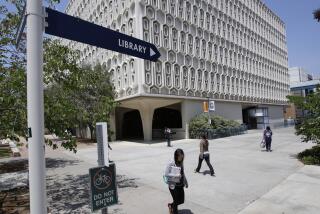Lower Costs for Higher Education Urged
- Share via
WASHINGTON — Urging colleges and universities to become more cost-efficient, a national commission Wednesday said these institutions bear prime responsibility for putting a stop to the soaring costs of a higher education.
The 11-member National Commission on the Cost of Higher Education released a list of recommendations for stemming the runaway price of attending college. The group found that among all colleges and universities, the combined total of tuition and fees has grown nearly twice as much as the actual cost to schools of educating students in the last 10 years.
This trend, the report concluded, helps explain why polls have shown that public concern about college affordability has hit a 30-year high.
Despite this, many schools have made few attempts to reduce their costs, the report said.
“If American colleges and universities don’t take the initiative, others will do it for them with a lot less care and a lot less imagination,” said Barry Munitz, commission vice chairman and president and chief executive of the J. Paul Getty Trust, a Los Angeles-based foundation for the visual arts and humanities. The report also expressed concern that some schools “have permitted a veil of obscurity to settle over their financial operations.”
The greatest gap in the growth of the price of a higher education and the costs to schools occurred among four-year public colleges and universities, where students paid 132% more in 1996 than they did in 1987 while the average cost per student rose by only 57%, according to the report.
At two-year public colleges, the figures were 85% and 52%, respectively.
At private four-year schools between 1987 and ‘96, the price for students increased by 99%, while costs to the schools were up by 69%.
Among all undergraduate and graduate students in the country, 78% attend public schools.
The report called on schools to make stronger efforts to control costs and increase productivity. “Efficiency is not a dirty word and should rank high in the vocabulary of higher education institutions,” said George Waldner, president of York College of Pennsylvania and a commission member.
But USC economics professor Morton Schapiro, an expert in college finances, said the problem is not that schools are wasting money. Instead, he said, they are just trying to provide too many course and degree offerings for too few students.
“The single biggest problem is that most colleges and universities are trying to do too much, and when you have that broad a scope it becomes very expensive to provide an education,” Schapiro said.
Other commission recommendations include:
* That schools explore alternative approaches to teaching and work with other institutions to share existing resources.
* That schools be held accountable to the public by gathering and disseminating accurate information on costs and prices.
* That federal and state governments reexamine regulation of higher education and eliminate requirements that prove too costly.
* That the federal government simplify and boost its student financial aid system.
The commission was created by Congress in response to the heightened public anxiety over college affordability.
The report will be presented to President Clinton and members of Congress and is available to colleges and universities nationwide.
More to Read
Sign up for Essential California
The most important California stories and recommendations in your inbox every morning.
You may occasionally receive promotional content from the Los Angeles Times.










